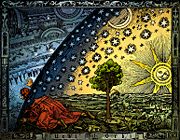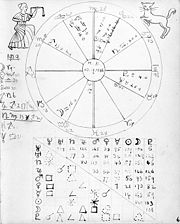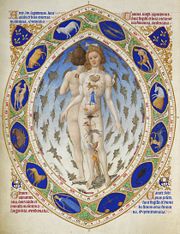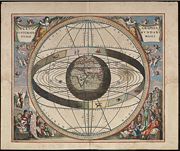Astrology
2008/9 Schools Wikipedia Selection. Related subjects: Recreation
Astrology (from Greek: ἄστρον, ἄστρου{ástron, ástrou}, "star"; and λόγος, λόγου{lógos, lógou}, "study of") is a group of systems, traditions, and beliefs in which knowledge of the apparent relative positions of celestial bodies and related details is held to be useful in understanding, interpreting, and organizing information about personality, human affairs, and other terrestrial matters. A practitioner of astrology is called an astrologer, or, rarely, an astrologist. Numerous traditions and applications employing astrological concepts have arisen since its earliest recorded beginnings in the 3rd millennium BC. It has played a role in the shaping of culture, early astronomy, and other disciplines throughout history.
Astrology and astronomy were often indistinguishable before the modern era, with the desire for predictive and divinatory knowledge one of the primary motivating factors for astronomical observation. Astronomy began to diverge from astrology after a period of gradual separation from the Renaissance up until the 18th century. Eventually, astronomy distinguished itself as the scientific study of astronomical objects and phenomena without regard to the astrological speculation of these phenomena.
Astrology can be defined as the study of the positions of celestial bodies in the belief that their movements either directly influence life on Earth or correspond somehow to events experienced on a human scale. Modern astrologers define astrology as a symbolic language, an art form, and a form of divination. Despite differences of definitions, a common assumption of astrology is the use of celestial placements in order to explain past and present events and predict the future. Generally, the scientific community considers astrology a pseudoscience or superstition. Despite its rejection by scientists, 31% of Americans polled expressed a belief in astrology and 39% considered it scientific according to another study.
| Astrology |
| Background |
|---|
| History of astrology |
| History of astronomy |
| Astrology and astronomy |
| Traditions |
| Babylonian astrology |
| Arab and Persian astrology |
| Chinese astrology |
| Hellenistic astrology |
| Indian astrology |
| Sidereal astrology |
| Western astrology |
| More... |
| Branches of horoscopic astrology |
| Natal astrology |
| Electional astrology |
| Horary astrology |
| Mundane astrology |
| More... |
| Categories |
| Astrologers |
| Astrological texts |
| Astrological writers |
| Astrology Portal |
Core beliefs
The core beliefs of astrology were prevalent in most of the ancient world and are epitomized in the Hermetic maxim "as above, so below". Tycho Brahe used a similar phrase to summarize his studies in astrology: suspiciendo despicio, "by looking up I see downward". Although the principle that events in the heavens are mirrored by those on Earth was once generally held in most traditions of astrology around the world, in the West there has historically been a debate among astrologers over the nature of the mechanism behind astrology. The debate also covers whether or not celestial bodies are only signs or portents of events, or if they are actual causes of events through some sort of force or mechanism.
Although the connection between celestial mechanics and terrestrial dynamics was explored first by Isaac Newton with his development of a universal theory of gravitation, claims that the gravitational effects of the celestial bodies are what accounts for astrological generalizations are not substantiated by scientific research, nor are they advocated by most astrologers.
Most astrological traditions are based on the relative positions and movements of various real or construed celestial bodies and on the construction of implied or calculated celestial patterns as seen at the time and place of the event being studied. These are chiefly the astrological planets, dwarf planets, the asteroids, the stars, the lunar nodes, Arabic parts and hypothetical planets. The frame of reference for such apparent positions is defined by the tropical or sidereal zodiac of twelve signs on one hand, and by the local horizon ( ascendant- descendant axis) and midheaven- imum coeli axis on the other. This latter (local) frame is typically further divided into the twelve astrological houses. Furthermore, the astrological aspects are used to determine the geometric/angular relationship(s) between the various celestial bodies and angles in the horoscope.
The claim of astrology to predict future trends and developments, or predictive astrology, is based on two main methods: astrological transits and astrological progressions. In astrological transits the ongoing movements of the planets are interpreted for their significance as they transit through space and the horoscope. In astrological progressions the horoscope is progressed forward in time according to set methods. Most modern astrologers no longer try to forecast actual events, but focus instead on general trends and developments. Skeptics respond that this allows astrologers to avoid making verifiable predictions, and gives them the ability to attach significance to arbitrary and unrelated events, in a way that suits their purpose.
In the past, astrologers often relied on close observation of celestial objects and the charting of their movements. Modern astrologers use data provided by astronomers which are transformed to a set of astrological tables called ephemerides, showing the changing zodiacal positions of the heavenly bodies through time.
Traditions
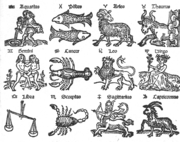
There are many traditions of astrology, some of which share similar features due to the transmission of astrological doctrines between cultures. Other traditions developed in isolation and hold different doctrines, though they too share some features due to drawing on similar astronomical sources.
Current traditions
The main traditions used by modern astrologers are:
- Vedic astrology
- Western astrology
- Chinese astrology
Vedic and Western astrology share a common ancestry as horoscopic systems of astrology, in that both traditions focus on the casting of an astrological chart or horoscope, a representation of celestial entities, for an event based on the position of the Sun, Moon, and planets at the moment of the event. However, Vedic astrology uses the sidereal zodiac, linking the signs of the zodiac to their original constellations, while Western astrology uses the tropical zodiac. Because of the precession of the equinoxes, over the centuries the twelve zodiacal signs in Western astrology no longer correspond to the same part of the sky as their original constellations. In effect, in Western astrology the link between sign and constellation has been broken, whereas in Vedic astrology it remains of paramount importance. Other differences between the two traditions include the use of 27 (or 28) nakshatras or lunar mansions, which have been used in India since Vedic times, and the system of planetary periods known as dashas.
In Chinese astrology a quite different tradition has evolved. By contrast to Western and Indian astrology, the twelve signs of the zodiac do not divide the sky, but rather the celestial equator. The Chinese evolved a system where each sign corresponds to one of twelve 'double-hours' that govern the day, and to one of the twelve months. Each sign of the zodiac governs a different year, and combines with a system based on the five elements of Chinese cosmology to give a 60 (12 x 5) year cycle. The term Chinese astrology is used here for convenience, but it must be recognised that versions of the same tradition exist in Korea, Japan, Vietnam, Thailand and other Asian countries.
In modern times, these traditions have come into greater contact with each other, notably with Indian and Chinese astrology having spread to the West, while awareness of Western astrology is still fairly limited in Asia. Astrology in the Western world has diversified greatly in modern times. New movements have appeared, which have jettisoned much of traditional astrology to concentrate on different approaches, such as a greater emphasis on midpoints, or a more psychological approach. Some recent Western developments include:
- Modern tropical and sidereal horoscopic astrology
- Cosmobiology
- Psychological astrology
- Sun sign astrology
- Hamburg School of Astrology
- Uranian astrology, subset of the Hamburg School
Historical traditions
Throughout its long history, astrology has come to prominence in many regions and undergone developments and change. There are many astrological traditions that are historically important, but which have largely fallen out of use today. Astrologers still retain an interest in them and regard them as an important resource. Historically significant traditions of astrology include:
- Arab and Persian astrology (Medieval, near East)
- Babylonian astrology (Ancient, near East)
- Egyptian astrology
- Hellenistic astrology (Classical antiquity)
- Mayan astrology
The history of Western, Chinese, and Indian astrology is discussed in the main article history of astrology.
Esoteric traditions
Many mystic or esoteric traditions have links to astrology. In some cases, like Kabbalah, this involves participants incorporating elements of astrology into their own traditions. In other cases, like divinatory tarot, many astrologers themselves have incorporated the tradition into their own practice of astrology. Esoteric traditions include, but are not limited to:
- Alchemy
- Chiromancy
- Kabbalistic astrology
- Medical astrology
- Numerology
- Rosicrucian or "Rose Cross"
- Tarot divination
Historically, alchemy in the Western World was particularly allied and intertwined with traditional Babylonian-Greek style astrology; in numerous ways they were built to complement each other in the search for occult or hidden knowledge. Astrology has used the concept of the four classical elements of alchemy from antiquity up until the present day. Traditionally, each of the seven planets in the solar system known to the ancients was associated with, held dominion over, and "ruled" a certain metal.
The zodiac

The zodiac is the belt or band of constellations through which the Sun, Moon, and planets transit across the sky. Astrologers noted these constellations and so attached a particular significance to them. Over time they developed the system of twelve signs of the zodiac ( Aries, Taurus, Gemini, Cancer, Leo, Virgo, Libra, Scorpio, Sagittarius, Capricorn, Aquarius, and Pisces), based on twelve of the constellations they considered to be particularly important. The Western and Vedic zodiac signs have a common origin in the tradition of horoscopic astrology, and so are very similar in meaning. In China on the other hand, the development of the zodiac was different. Although the Chinese too have a system of twelve signs (named after animals), the Chinese zodiac refers to a pure calendrical cycle, as there are no equivalent constellations linked to it like the Western or Indian zodiacs. The common choice of twelve zodiac signs is understandable considering the interaction of the Sun and Moon was central to all forms of astrology.
The majority of Western astrologers base their work on the tropical zodiac which divides the sky into twelve equal segments of 30 degrees each, beginning with the first point of Aries, the point where the line of the earth's celestial equator and the ecliptic (the Sun's path through the sky) meet at the northern hemisphere spring equinox. Due to the precession of the equinoxes, the slow changing of the way Earth rotates in space, the zodiacal signs in this system bear no relation to the constellations of the same name but stay aligned to the months and seasons.
Practitioners of the Vedic astrological tradition and a minority of Western astrologers use the sidereal zodiac. This zodiac uses the same evenly divided ecliptic but approximately stays aligned to the positions of the observable constellations with the same name as the zodiacal signs. The sidereal zodiac differs from the tropical zodiac by an offset called the ayanamsa, which steadily increases as the equinoxes drift further. Furthermore, some siderealists (i.e. astrologers employing sidereal techniques) use the actual, unequal constellations of the zodiac in their work.
Horoscopic astrology

Horoscopic astrology is a system that was developed in the Mediterranean region and specifically Hellenistic Egypt around the late 2nd or early 1st century BCE. The tradition deals with two-dimensional diagrams of the heavens, or horoscopes, created for specific moments in time. The diagram is then used to interpret the inherent meaning underlying the alignment of celestial bodies at that moment based on a specific set of rules and guidelines. A horoscope was calculated normally for the moment of an individual's birth, or at the beginning of an enterprise or event, because the alignments of the heavens at that moment were thought to determine the nature of the subject in question. One of the defining characteristics of this form of astrology that makes it distinct from other traditions is the computation of the degree of the Eastern horizon rising against the backdrop of the ecliptic at the specific moment under examination, otherwise known as the ascendant. Horoscopic astrology has been the most influential and widespread form of astrology across the world, especially in Africa, India, Europe, and the Middle East, and there are several major traditions of horoscopic astrology whose origins are Hellenistic, including Indian, Medieval, and most other modern Western traditions of astrology.
The horoscope
Central to horoscopic astrology and its branches is the calculation of the horoscope or astrological chart. This two-dimensional diagrammatic representation shows the celestial bodies' apparent positions in the heavens from the vantage of a location on Earth at a given time and place. The horoscope is also divided into twelve different celestial houses which govern different areas of life. Calculations performed in casting a horoscope involve arithmetic and simple geometry which serve to locate the apparent position of heavenly bodies on desired dates and times based on astronomical tables. In ancient Hellenistic astrology the ascendant demarcated the first celestial house of a horoscope. The word for the ascendant in Greek was horoskopos from which horoscope derives. In modern times, the word has come to refer to the astrological chart as a whole.
Branches of horoscopic astrology
Traditions of horoscopic astrology can be divided into four branches which are directed towards specific subjects or purposes. Often these branches use a unique set of techniques or a different application of the core principles of the system to a different area. Many other subsets and applications of astrology are derived from these four fundamental branches.
- Natal astrology, the study of a person's natal chart to gain information about the individual and his/her life experience.
- Katarchic astrology, which includes both electional and event astrology. The former uses astrology to determine the most auspicious moment to begin an enterprise or undertaking, and the latter to understand everything about an event from the time at which it took place.
- Horary astrology, used to answer a specific question by studying the chart of the moment the question is posed to an astrologer.
- Mundane or world astrology, the application of astrology to world events, including weather, earthquakes, and the rise and fall of empires or religions. This includes the Astrological Ages, such as the Age of Aquarius, Age of Pisces and so on. Each age is about 2,150 years in length and many people believe these massive ages correspond to major historical events and current developments in the world
History of astrology
Origins
The origins of much of the astrological doctrine and method that would later develop in Asia, Europe, and the Middle East are found among the ancient Babylonians and their system of celestial omens that began to be compiled around the middle of the 2nd millennium BCE. This system of celestial omens later spread either directly or indirectly through the Babylonians and Assyrians to other areas such as India, Middle East, and Greece where it merged with pre-existing indigenous forms of astrology.. This Babylonian astrology came to Greece initially as early as the middle of the 4th century BCE, and then around the late 2nd or early 1st century BCE after the Alexandrian conquests, this Babylonian astrology was mixed with the Egyptian tradition of decanic astrology to create horoscopic astrology. This new form of astrology, which appears to have originated in Alexandrian Egypt, quickly spread across the ancient world into Europe, the Middle East and India.
Before the modern era
From the classical period through the scientific revolution, astrological training played a critical role in advancing astronomical, mathematical, medical and psychological knowledge. Astrological influences included the observation and long-term tracking of celestial objects. It was astrologers who provided the first systematic documentation of the movements of the Sun, the Moon, the planets, and the stars. The differentiation between astronomy and astrology varied from place to place; they were indistinguishable in ancient Babylonia and medieval Europe, but separated to an extent in the Hellenistic world. The first semantic distinction between astrology and astronomy was given in the 11th century by the Persian astronomer, Abū Rayhān al-Bīrūnī (see astrology and astronomy).
The pattern of astronomical knowledge gained from astrological endeavours has been historically repeated across numerous cultures, from ancient India through the classical Maya civilization to medieval Europe. Given this historical contribution, astrology has been called a protoscience along with pseudosciences such as alchemy (see "Western astrology and alchemy" below).
Astrology was not always uncritically accepted before the modern era; it was often challenged by Hellenistic skeptics, church authorities, and medieval Muslim astronomers, such as Al-Farabi (Alpharabius), Ibn al-Haytham (Alhazen), Abū Rayhān al-Bīrūnī, Avicenna and Averroes. Their reasons for refuting astrology were often due to both scientific (the methods used by astrologers being conjectural rather than empirical) and religious (conflicts with orthodox Islamic scholars) reasons. Ibn Qayyim Al-Jawziyya (1292-1350), in his Miftah Dar al-SaCadah, used empirical arguments in astronomy in order to refute astrology and divination.
Many prominent thinkers, philosophers and scientists, such as Pythagoras, Plato, Aristotle, Galen, Paracelsus, Girolamo Cardan, Nicholas Copernicus, Taqi al-Din, Tycho Brahe, Galileo Galilei, Johannes Kepler, Carl Jung and others, practiced or significantly contributed to astrology.
Effects on world culture
Astrology has had a profound influence over the past few thousand years on Western and Eastern cultures. In the Middle Ages, when the educated of the time believed in astrology, the system of heavenly spheres and bodies was believed to reflect on the system of knowledge and the world itself below.
Astrology has had an influence on both language and literature. For example, influenza, from medieval Latin influentia meaning influence, was so named because doctors once believed epidemics to be caused by unfavorable planetary and stellar influences. The word "disaster" comes from the Italian disastro, derived from the negative prefix dis- and from Latin aster "star", thus meaning "ill-starred". Adjectives "lunatic" (Luna/Moon), "mercurial" (Mercury), "venereal" (Venus), "martial" (Mars), "jovial" (Jupiter/Jove), and "saturnine" (Saturn) are all old words used to describe personal qualities said to resemble or be highly influenced by the astrological characteristics of the planet, some of which are derived from the attributes of the ancient Roman gods they are named after. In literature, many writers, notably Geoffrey Chaucer and William Shakespeare, used astrological symbolism to add subtlety and nuance to the description of their characters' motivation(s). More recently, Michael Ward has proposed that C.S. Lewis imbued his Chronicles of Narnia with the characteristics and symbols of the seven heavens. Often, an understanding of astrological symbolism is needed to fully appreciate such literature.
Some modern thinkers, notably Carl Jung, believe in astrology's descriptive powers regarding the mind without necessarily subscribing to its predictive claims. In education astrology is reflected in the university education of medieval Europe, which was divided into seven distinct areas, each represented by a particular planet and known as the seven liberal arts. Dante Alighieri speculated that these arts, which grew into the sciences we know today, fitted the same structure as the planets. In music the best known example of astrology's influence is in the orchestral suite called "The Planets" by the British composer Gustav Holst, the framework of which is based upon the astrological symbolism of the planets.
Astrology and science
| Pseudoscientific Concepts | |
|---|---|
| Claims: | |
|
Position of the planets determines personality and human events. |
|
| Related scientific disciplines: | |
| Year proposed: |
antiquity |
|
Original proponents: |
ancient priests and astrologers |
|
Current proponents: |
Philip Berg, Rob Brezsny, Michel Gauquelin, Linda Goodman, Sydney Omarr, Joan Quigley, Jackie Stallone, Athena Starwoman, Shelley von Strunckel, Richard Tarnas |
By the time of Francis Bacon and the scientific revolution, newly emerging scientific disciplines acquired a method of systematic empirical induction validated by experimental observations, which led to the scientific revolution. At this point, astrology and astronomy began to diverge; astronomy became one of the central sciences while astrology was increasingly viewed as an occult science or superstition by natural scientists. This separation accelerated through the eighteenth and nineteenth centuries.
Astrology is now regarded as unscientific both by scientific bodies and by individual scientists and has been labeled as a pseudoscience. In 1975, the American Humanist Association published one of the most widely known modern criticisms of astrology, characterizing those who continue to have faith in the subject as doing so "in spite of the fact that there is no verified scientific basis for their beliefs, and indeed that there is strong evidence to the contrary". Astronomer Carl Sagan found himself unable to sign the statement, not because he felt astrology had any validity at all, but because he found the statement's tone authoritarian. Sagan stated that he would instead have been willing to sign a statement describing and refuting the principal tenets of astrological belief, which he believed would have been far more persuasive and would have produced much less controversy than the circulated statement.
Although astrology has had no scientific standing for some time, it has been the subject of much research among astrologers since the beginning of the twentieth century. In their landmark study of twentieth-century research into natal astrology, astrology critics Geoffrey Dean and coauthors documented this burgeoning research activity, primarily within the astrological community.
Claims about obstacles to research
Astrologers have argued that there are significant obstacles in carrying out scientific research into astrology today, including lack of funding, lack of background in science and statistics by astrologers, and insufficient expertise in astrology by research scientists and skeptics. There are only a handful of journals dealing with scientific research into astrology (i.e. astrological journals directed towards scientific research or scientific journals publishing astrological research). Some astrologers have argued that few practitioners today pursue scientific testing of astrology because they feel that working with clients on a daily basis provides a personal validation for them.
Another argument made by astrologers is that most studies of astrology do not reflect the nature of astrological practice and that the scientific method does not apply to astrology. Some astrology proponents claim that the prevailing attitudes and motives of many opponents of astrology introduce conscious or unconscious bias in the formulation of hypotheses to be tested, the conduct of the tests, and the reporting of results.
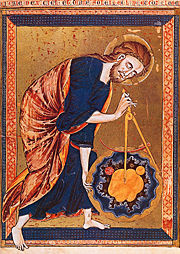
Mechanism
As astrologers have been consistently unable to present physical mechanisms for astrology, few modern astrologers believe in a direct causal relationship between heavenly bodies and earthly events. An editorial published by the Astronomical Society of the Pacific reports that they can find no evidence for a scientifically defined mechanism by which celestial objects can influence terrestrial affairs. Some researchers have posited acausal, purely correlative, relationships between astrological observations and events, such as the theory of synchronicity proposed by Carl Jung. Others have posited a basis in divination. Still others have argued that empirical correlations can stand on their own epistemologically, and do not need the support of any theory or mechanism. To some observers, these non-mechanistic concepts raise serious questions about the feasibility of validating astrology through scientific testing, and some have gone so far as to reject the applicability of the scientific method to astrology almost entirely. Some astrologers, on the other hand, believe that astrology is amenable to the scientific method, given sufficiently sophisticated analytical methods, and they cite pilot studies they claim support this view. Consequently, several astrologers have called for or advocated continuing studies of astrology based on statistical validation.
Research
Astrology has repeatedly failed to demonstrate its effectiveness in numerous controlled studies. Effect size studies in astrology conclude that the mean accuracy of astrological predictions is no greater than what is expected by chance, and astrology's perceived performance has disappeared on critical inspection. When testing for cognitive, behavioural, physical and other variables, one study of astrological " time twins" showed that human characteristics are not molded by the influence of the Sun, Moon and planets at the time of birth. Skeptics of astrology also suggest that the perceived accuracy of astrological interpretations and descriptions of one's personality can be accounted for by the fact that people tend to exaggerate positive 'hits' and overlook whatever does not fit, especially when vague language is used. They also argue that statistical research is often wrongly seen as evidence for astrology due to uncontrolled artifacts. A large-scale study, with a sample size of about 15,000 "astro-twins", was published in 2006. It examined the relationship between date of birth and individual differences in personality and general intelligence, and found no evidence that a connection existed. It also found no relationship between the zodiacal signs and participants' personal traits.
French psychologist and statistician Michel Gauquelin claimed to have found correlations between some planetary positions and certain human traits such as vocations. Gauquelin's most widely known claim is known as the Mars effect, which is said to demonstrate a correlation between the planet Mars occupying certain positions in the sky more often at the birth of eminent sports champions than at the birth of ordinary people. A similar claim is made by Richard Tarnas in his work Cosmos and Psyche, in which he explores correspondences between planetary alignments and historically significant events and individuals.
Since its original publication in 1955, the Mars effect has been the subject of critical studies and skeptical publications which refute it, and studies in fringe journals claiming to support or expand the original claims. Gauquelin's research has not received mainstream scientific notice.
The Forer effect is seen in astrology when most people simply accept their horoscopes as custom even if, by logic, it would mean that 1/12 of the world would have the exact same day or week.
